#Imperial Trans-Antarctic Expedition
Text
I know Alfred Lansing wrote Endurance back in the 1950s, but it's funny to me that he seems so surprised about the "three girls" who applied for positions on the Imperial Trans-Antarctic Expedition. If my time in the Terror fandom has taught me anything, it's that the desire to go on a polar expedition in a big wooden ship transcends gender roles.
#endurance#alfred lansing#polar exploration#imperial trans-antarctic expedition#ernest shackleton#the terror amc#the terror
125 notes
·
View notes
Text
Endyuaransu Gō daihyōryū
New item:

Describes the events of the 1914 Shackleton Antarctic expedition, when the ship the Endurance was crushed in a frozen sea and the men made the perilous journey across ice and stormy seas to reach inhabited land.
Shelf: 290.92 KIM JPN (@ tadoku section)
[Ice story. English].
Endyuaransu Gō daihyōryū = Ice story : Shackleton's lost expedition. by Erizabesu Kōdī Kimeru ; translated by Chiba Shigeki.
Tōkyō : Asunaro Shobō, 2000.
ISBN: 9784751518144
167 pages : illustrations, map, portraits ; 21 cm.
Translated into Japanese from the English, moderate furigana on kanji chracters.
#antarctica#endurance (ship)#imperial trans-antarctic expedition (1914-1917)#ernest shackleton#tadoku level 5
1 note
·
View note
Text

Endurance frozen in the ice, 1914-1917. Frank Hurley
Platinum print.
The Endurance was an exploration ship that became trapped in pack ice in the Weddell Sea off the coast of Antarctica in 1915. It was Sir Ernest Shackleton's Imperial Trans-Antarctic Expedition. The ship was squeezed by the ice for ten months before being crushed, but the crew all survived.
#photography#fotografia#fotografie#photographie#black and white#foto#vintage#arctic#1900s#ships#histoire#history#historia#nature
2K notes
·
View notes
Text

Irish seaman and Antarctic explorer Thomas Crean photographed in 1915 aboard the Endurance in Antarctica during the Imperial Trans-Antarctic Expedition of 1914–1917 led by Ernest Shackleton.
The Endurance was trapped in ice for 492 days and sank, so the 28-man crew had to use lifeboats to reach the uninhabited Elephant Island. Crean was one of 6 members of the crew to make the 800 miles (1300 km) journey from Elephant Island to South Georgia in the small-boat James Caird to seek rescue for the rest of the crew. Once they reached South Georgia after 17 days at sea, 3 of the men, including Tom Crean, trekked across the island to a whaling station on the north side of South Georgia. There they were able to organize rescue efforts for the 3 men left on the south of the island and the remaining crew on Elephant Island. The entire crew of the Endurance returned home without loss of life.
Credit: polar_history_in_colour on Instagram
92 notes
·
View notes
Text

12 June 2024
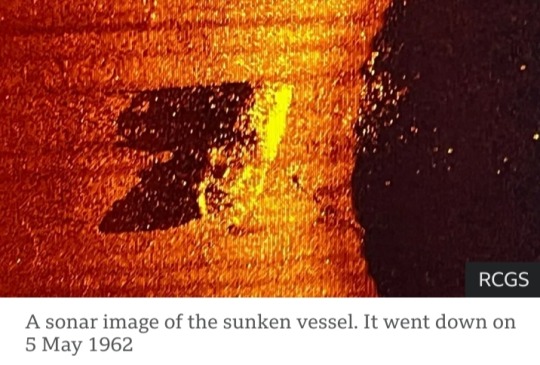
Wreck hunters have found the ship on which the famous polar explorer Ernest Shackleton made his final voyage.
The vessel, called "Quest," has been located on the seafloor off the coast of Newfoundland, Canada.
Shackleton suffered a fatal heart attack on board on 5 January 1922 while trying to reach the Antarctic.
And although Quest continued in service until it sank in 1962, the earlier link with the explorer gives it great historic significance.
The British-Irish adventurer is celebrated for his exploits in Antarctica at a time when very few people had visited the frozen wilderness.
"His final voyage kind of ended that Heroic Age of Exploration, of polar exploration, certainly in the south," said renowned shipwreck hunter David Mearns, who directed the successful search operation.
"Afterwards, it was what you would call the scientific age. In the pantheon of polar ships, Quest is definitely an icon," he told BBC News.
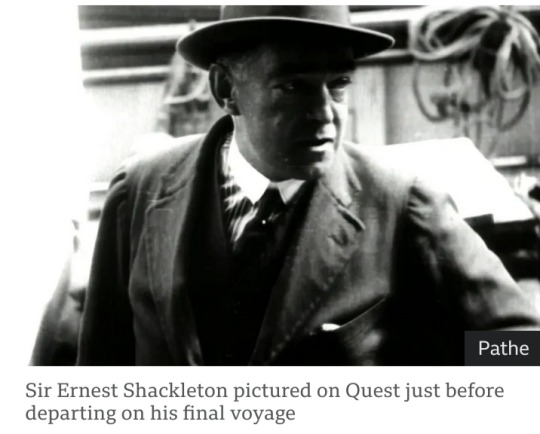
The remains of the ship, a 38m-long schooner-rigged steamship, were discovered at the bottom of the Labrador Sea on Sunday by a team led by The Royal Canadian Geographical Society (RCGS).
Sonar equipment found it in 390m (1,280ft) of water. The wreck is sitting almost upright on a seafloor that has been scoured at some point in the past by the passing of icebergs.
The main mast is broken and hanging over the port side, but otherwise, the ship appears to be broadly intact.
Quest was being used by Norwegian sealers in its last days. Its sinking was caused by thick sea-ice, which pierced the hull and sent it to the deep.
The irony, of course, is this was the exact same damage inflicted on Shackleton's Endurance - the ship he used on his ill-fated Imperial Trans-Antarctic Expedition of 1914–1917.
Fortunately, the crews of both Endurance, in 1915, and Quest, in 1962, survived.
Indeed, many of the men who escaped the Endurance sinking signed up for Shackleton's last polar mission in 1921-1922, using Quest.
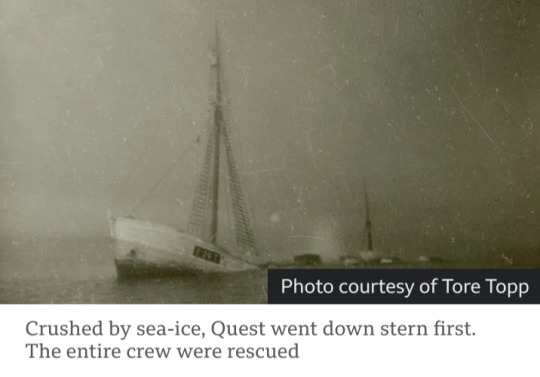
His original plan had been to explore the Arctic, north of Alaska, but when the Canadian government withdrew financial support, the expedition headed south in Quest to the Antarctic.
The new goal was to map Antarctic islands, collect specimens and look for places to install infrastructure, such as weather stations.
Shackleton never made it, however, struck down by heart failure in the Port of Grytviken on the British Overseas Territory of South Georgia, the last stop before reaching the White Continent. He was just 47 years old.
After his death, Quest was involved in other important expeditions, including the 1930-31 British Arctic Air Route Expedition led by British explorer Gino Watkins, who himself tragically died aged 25 while exploring Greenland.
Quest was also employed in Arctic rescues and served in the Royal Canadian Navy during WWII, before being turned over to the sealers.

The RCGS team members carried out extensive research to find Quest's last resting place.
Information was gathered from ship's logs, navigation records, photographs, and documents from the inquiry into her loss.
The calculated sinking location in the Labrador Sea was pretty much spot on, although the exact co-ordinates are being held back for the time being.
A second visit to the wreck, possibly later this year, will do a more complete investigation.
"Right now, we don't intend to touch the wreck. It actually lies in an already protected area for wildlife, so nobody should be touching it," associate search director Antoine Normandin said.
"But we do hope to go back and photograph it with a remotely operated vehicle, to really understand its state."
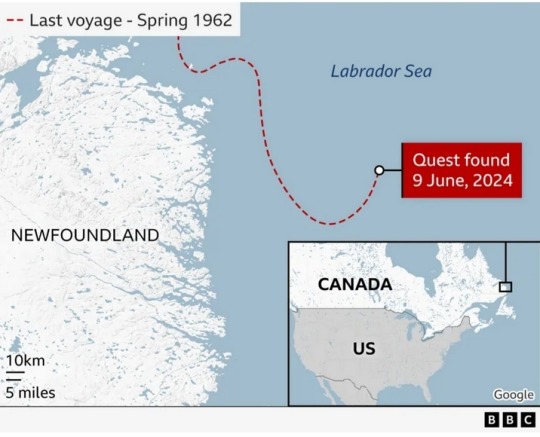
Alexandra Shackleton is the explorer's granddaughter and was patron to the RCGS survey.
"I was thrilled, really excited to hear the news; I have relief and happiness and a huge admiration for the members of the team," she told BBC News.
"For me, this represents the last discovery in the Shackleton story. It completes the circle."
The explorer continues to spark interest more than a century after his death.
Hundreds of people visit his grave on South Georgia every year to pay their respects to the man known by his crews simply as "The Boss."
"Shackleton will live forever as one of the greatest explorers of all time, not just because of what he achieved in exploration but for the way he did it, and the way he looked after his men," said David Mearns.
"His story is timeless and will be told again and again; and I'm just one of many disciples who'll keep telling it for as long as I can."
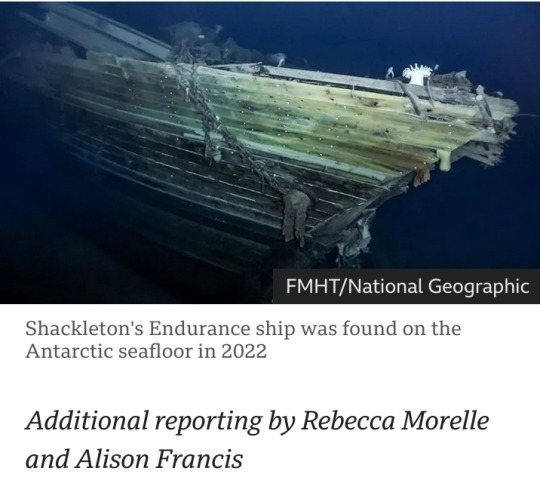
—
Sir Ernest Henry Shackleton CVO OBE FRGS FRSGS (15 February 1874 – 5 January 1922) was an Anglo-Irish Antarctic explorer who led three British expeditions to the Antarctic.
He was one of the principal figures of the period known as the Heroic Age of Antarctic Exploration.
#Ernest Shackleton#Quest#Newfoundland#Canada#Antarctic#polar explorer#shipwreck hunter#shipwreck#Labrador Sea#The Royal Canadian Geographical Society (RCGS)#Endurance#1930-31 British Arctic Air Route Expedition#Gino Watkins#sonar instrument#Heroic Age of Antarctic Exploration#Sir Ernest Henry Shackleton#British expeditions
59 notes
·
View notes
Text

In the Futurama episode The Birdbot of Ice-Catraz, cold, logical Bender takes over as captain of the Planet Express ship.
As part of Bender's, uh, leadership style he gives Fry, his first mate, the informal nickname of "Wiggles."
Now, I don't know for certain, but I think this joke is rooted in some history - specifically, one of my all time favorite historical figures: Sir Ernest Shackleton (in fact, I came thiiiis close to naming my son Ernest):


One of Shakleton's most famous expeditions was an ill-fated, failure of a mission called the Imperial Trans-Antarctic Expedition aboard the ship Endurance. On one hand it was a total failure because they did not achieve any of their objectives, BUT on the other hand it was a total success because Shackleton kept the crew together while being trapped FOR THREE YEARS in the middle of the South Pole. Despite all of those failures, he didn't lose a single man. Everyone made it home safely - the only casualty being the one stowaway's feet (frostbite).
Shackleton is a fascinating man and a great leader:

Now, this next part isn't exactly something Shackleton did, BUT there was one crew member on the Endurance for the Imperial Trans-Antarctic Expedition, Frank Worsley. In fact, Worsley was the captain of Endurance and Shakleton's right hand man.


What did everyone on board call Worsley!?!?!?!
WUZZLES!
Again, I have no clue if this was intentional with Fry's nickname being Wiggles, but I like to think it is!
#futurama#philip j. fry#turanga leela#zoidberg#bender bending rodriguez#the birdbot of ice-catraz#history#lit with leela#shakleton
13 notes
·
View notes
Photo
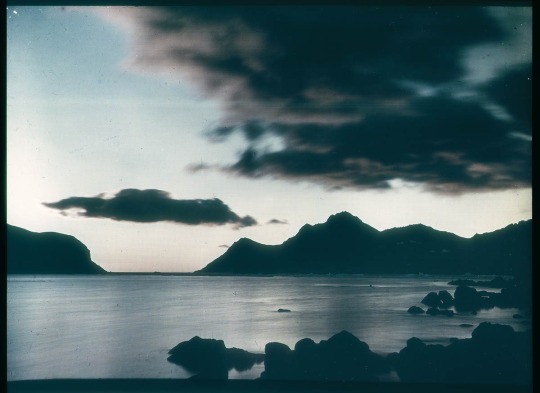
A Sub-Antarctic sunrise. South Georgia, British Imperial Trans-Antarctic Expedition, 1914-1917 / Paget plates by Frank Hurley.
223 notes
·
View notes
Text

Frank Arthur Worsley -1872-1943 sailor, member of the Imperial Trans-Antarctic Expedition (1914-1917) under the leadership of Ernest Shackleton (captain of the Endurance), member of Shackleton's expedition on the Quest in 1920-1921.
#Courage #Professionalism #Memory #Respect #Expedition #Antarctica #Discoveries #Polar Voyages #history foto
32 notes
·
View notes
Note
I just took your uquiz (got Madhouse at the End of the World) and I'm obsessed - I think I might have found a new special interest!!! Please talk polar expeditions to me, I'm foaming at the mouth, absolutely feral. Just infodump like crazy please, I'm on my knees and begging
I'm so glad you liked the quiz!!
Apologies for turning this post into a larger primer!
I hope you enjoy Madhouse--secretly I think it's the best result on the quiz (though it's not my own result; that's A First-Rate Tragedy). Madhouse has a bit of everything & if you're looking for truly insane anecdotes to regale your friends with, it's your best bet. A smattering of what you'll find in Madhouse: an army of rats, toxic gases sickening the expedition leader, scientists drawing cartoons about poop and butts, a man being mistaken for a seal at the worst possible time, brutal disregard for cats by a man who would go on to co-found the International Astronomical Union, the invention of light therapy, really bad uses of petroleum jelly....& that's just scratching the surface! And it all takes place during the first overwintering in Antarctica. thisisfine.gif
The one downside (not a downside depending on your perspective) for Madhouse as a starter book is it has nothing to do with Shackleton or Scott, and you'll soon find the majority of the English-language books on the Heroic Age, for better or worse, relate to those two. Madhouse DOES have a young Roald Amundsen (later the first man to the South Pole), who is a FASCINATING figure, and his first trip to Antarctica was often overlooked before this book afaik.
So I chose my three books for the starter quiz very carefully. Madhouse at the End of the Earth by Julian Sancton, A First-Rate Tragedy by Diana Preston, and Endurance by Alfred Lansing are all accessible secondary sources. They are readable (not overly academic) & don't require background info, doing a good job introducing people and terms (polar exploration has a whole associated vocabulary). Just as importantly, they're all exciting & well-paced & gripping! Once you've found your bearings, there's a whole specialist literature of polar history for polar scholars and enthusiasts. Broadly, I break it down thusly:
- Primary source expedition narratives: firsthand accounts of expeditions by people who were there. Within this there are a few subcategories: books always intended to be written by explorers when they returned home (this was a significant source of income for expeditions), like Scott's The Voyage of the Discovery, Mawson's Home of the Blizzard, or Shackleton's The Heart of the Antarctic. There's books not-originally-intended but the author decided to write them years later (The Worst Journey in the World by Cherry-Garrard, Saga of the Discovery by Bernacchi). And then there's diaries that were never intended to be published--often, they were written for the explorer's family, or perhaps to help the expedition leader write the narrative. But they weren't meant to be published verbatim. Time, fame, tragedy, and general interest sometimes led to them eventually seeing publication--this is especially the case for a lot of the Terra Nova diaries, & was most famously done for Scott's own diary, which he had intended to edit into a book, but not to publish in raw form. Providence, of course, had different ideas.
- Secondary source expedition narratives: Madhouse and Endurance from my quiz both fit this category, for the Belgica and Imperial Trans-Antarctic (better known as the 'Endurance') expeditions, respectively. (First-Rate Tragedy I'd moreso call a Scott biography). These are accounts of expeditions written by authors/historians who were not on the expeditions in question. There's a LOT of these, and they vary widely in quality. Some offer new scholarship or cover something that hasn't been covered before; others are...less rigorous. Have a browse at your local thrift store/charity shop/secondhand bookstore. If you're lucky they'll have some polar books. Flip through and see if there's a robust citations section, or footnotes, and ideally in-text citations for quote attributions. This can give you some sense of the quality as you're wading into the sea of books!
- Biographies: Exactly what it says on the tin! Instead of picking an expedition to focus on, these books are about one explorer and his life (almost always "his", though there are a few exceptions like Ada Blackjack). There are, once again, a lot of these! Scott and Shackleton in particular have a lot of biographies. I personally didn't read many biographies before this obsession, and I find them a really interesting format in which the biographer is important too, not just the subject. I'm developing opinions about when and how biographers should include relevant cultural context, the amount of the author inserting their opinion that I prefer and how it should be indicated in the text, etc. Similarly for the secondary sources above, check the indices and citations. I'm constantly flipping back to check sources while reading, one of the reasons I prefer physical to e-books!
- Other: There's always another category, isn't there? There's tons more! Cultural histories like Spufford's I May Be Some Time: Ice and the English Imagination (I recommend you get a few books under your belt before reading that to get the most out of it), travelogues mixed with history like Sarah Wheeler's Terra Incognita, Bea Uusma's The Expedition which flips back and forth between time periods, & more!
Like any taxonomy, there's flaws with the above, and things that don't fit, but that's broadly how I see the landscape!
Tips, tricks, & things to know:
- Polar books are most often found in the "Travel" or "Travel Literature" section. Sometimes you can find stuff in "History" "Biography" or even "Sports" lol. A parallel interest is Mountaineering, so if a place has Mountaineering books, they may well also have polar.
- It can be very helpful to familiarise yourself with the Edwardian era in general -- it's a fascinating cultural history in and of itself, and its the most modern era before the great global "end-of-innocence" of the First World War. Sometimes the things these guys are up to really ARE crazy, sometimes it's just that they're Edwardians and something is lost in the translation.
- Like many subjects historians have been writing about for over a century, polar exploration history authors have their biases. The most common one is whether or not the author likes Robert Falcon Scott. This goes back to a controversial book called Scott and Amundsen, published in 1979 by Roland Huntford. (It's also found under the title The Last Place on Earth, based on its TV show adaptation.) Huntford retells the "race to the South Pole" elevating Amundsen and in the process doing a very good job of destroying Scott's reputation by debunking him as an incompetent bungler. From what I've heard from others (I haven't read it yet, though will eventually for its historiographical value) it's a good source on Amundsen but everything he says on Scott should be ignored due to highly selective quotations and...well, active malice toward the guy. Basically, it's a callout-post/bombshell of a book that has had almost every subsequent historian touching on the topic going to great lengths to debunk in turn. Fwiw, I've also heard people say Huntford's Shackleton biography is good. Just. Don't listen to him about Scott.
- Imperialism motivated a lot of these expeditions, and frankly in my opinion this is something more of the literature NEEDS to talk about! A few that do a good job are Spufford mentioned above, & Larson's An Empire of Ice.
- I'd actually recommend don't start with diaries, bc they usually need some context to understand. Exception? Scott's final entries.
There you go! Happy reading! Also check out @areyougonnabe, she's got some great polar posts!!
#polar exploration#and I didn't even touch on the fictional adaptations#sorry this probably isn't want you wanted but its what ive written!
33 notes
·
View notes
Text
Ep 279: The Third Man Syndrome Part 1
"Who is the third who walks always beside you? When I count, there are only you and I together But when I look ahead up the white road There is always another one walking beside you" -- The Waste Land by T. S. ELIOT
Description:
A strange occurrence often happens to people engaged in an adventurous activity or who fall victim to an unfortunate circumstance. They find themselves with a companion whose presence would typically be impossible. Usually, the person is at a critical moment in a life-or-death situation in an extreme and unusual environment. When they are weakened and dying from exposure, suffering privation of sustenance, lost and alone, when they are about to lose all hope and accept their demise, that’s when this otherworldly friend suddenly appears to render aid and encouragement, giving them a superhuman will or strength to survive. Psychologists label this a “sensed presence experience” but are at a loss for a simple explanation. These presences may be seen, heard, and sometimes even touched. They appear in dire situations to people from all walks of life. They may materialize as a known friend, a deceased relative, a religious figure, or an indeterminate benefactor. Still, whatever their form, there is no doubt to the one in danger that this being is real and there with them. Although this sensed presence appears most often to mountain climbers, sailors, divers, and polar explorers, it can also happen to astronauts, prisoners of war, and disaster survivors. One of the most intriguing aspects of the sensed presence experience is that the ethereal saviors aren’t just there to provide comforting words; they actually help with knowledgable advice or guidance or can even seemingly take over the actions of the afflicted – whatever is necessary to increase the odds of survival. Join us as we explore a phenomenon more common than you might think, a syndrome also known as the “Third Man.”
Reference Links:
“The Sensed Presence as a Coping Resource in Extreme Environments”
by Peter Suedfeld & John Geiger. From Miracles: God, Science, and Psychology in the Paranormal on Omnilogos.com
“The Sensed Presence as A Coping Resource in Extreme Environments” on the Julian Jaynes Society website
“How does our understanding of the sensed presence phenomenon in extreme settings change the way we talk about so-called mental ‘illnesses’ in daily life?” by Blaise Cottingham on Medium.com
Angels of Mons on Wikipedia
Vincent Lam
“Extreme environment” on Wikipedia
King Nebuchadnezzar from Daniel 3:24-5 on BibleGateway.com
The Savage Curtain episode of the original Star Trek series
“Charles Lindbergh and the Third Man Factor” on Theresa's Haunted History of the Tri-State blog
Poet, memoirist, and songwriter Mary Karr
“The Liars’ Club” by Mary Karr
Kanchenjunga, the world’s third highest mountain, on Britannica.com
“Wilson,” the volleyball from the motion picture Castaway
“Ernest Shackleton's Crew of the Endurance – Imperial Trans Antarctica Expedition 1914 -17” on CoolAntarctica.com
Husvik, the former whaling station on the north-central coast of South Georgia Island, Antarctica
Elephant Island, Antarctica
“Excerpt: The Voyage of the James Caird by Ernest Shackleton” from the American Museum of Natural History website
Alfred Lansing
Caedmon, widely considered to be the world’s first audiobook and launch of the spoken word industry
“The Waste Land” by T. S. Eliot on Project Gutenberg
Stromness, South Georgia
Sir Ernest Shackleton and T S Eliot’s ‘third man’ from the Royal Scottish Geographical Society
The Waste Land Part I – The Burial of the Dead from the Poetry Archive
The Waste Land from The Poetry Foundation
“T. S. ELIOT SAW ALL THIS COMING” from The Atlantic
The Waste Land on Wikipedia
Jane S. P. Mocellin and Peter Suedfeld’s research on behavior in extreme environments from ResearchGate.net
“Shackleton's whisky returned to Antarctic hut” on CBC.ca
“Spirits of the South Pole” from The New York Times Magazine
“Wild Survival Story About 1983 Rockies Alpine Avalanche” – the story of Jim Sevigny and Richard Whitmire
Distance Line for cave diving
“UK scientist has her lab in underwater caves” – Stephanie Schwabe article from the Lexington Herald-Leader
Kendal Mint Cake on Wikipedia
Romney’s Kendal Mint Cake on Amazon
Reinhold Messner
“The Unauthorized Biography of Reinhold Messner” music album by the band Ben Folds Five
Related Books:
Suggested Listening:
Find us on YouTube!
Click this text to find all Astonishing Legends episodes and more on our Youtube Channel https://www.youtube.com/c/Astonishinglegends
Join us on Patreon!
Click HERE or go to patreon.com/astonishinglegends to become one of our Patreon members and receive exclusive offerings, like our bonus Astonishing Junk Drawer episodes (posted every weekend the main show is dark) commercial-free episodes, and more!
SPECIAL OFFERS FROM OUR SPECIAL SPONSORS:
FIND OTHER GREAT DEALS FROM OUR SHOW’S SPONSORS BY CLICKING HERE!
CREDITS:
Episode 279: The Third Man Syndrome Part 1. Produced by Scott Philbrook & Forrest Burgess. Audio Editing by Sarah Vorhees Wendel of VW Sound. Music and Sound Design by Allen Carrescia. Tess Pfeifle, Producer and Lead Researcher. Ed Voccola, Technical Producer. Research Support from The Astonishing Research Corps, or "A.R.C." for short. Copyright 2024 Astonishing Legends Productions, LLC. All Rights Reserved.
#2024#279#Third Man Syndrome#Third Man Factor#Third Man Phenomenon#sensed presence experience#extreme and unusual environments#John Geiger#Peter Suedfeld#Ernest Shackleton#South Pole#Reinhold Messner#guardian angel#Spirit Guides#higher self#astral self#bicameral mind#Lindbergh#Antarctica#Mount Everest#cave diving
11 notes
·
View notes
Text
I was talking to my dad about antarctic exploration yesterday, and he said that Baron Adrien de Gerlache was the turn-of-the-20th-century equivalent of the OceanGate submarine morons.
I'm not sure how to feel about the fact that he's absolutely not wrong about that.
#as much as I love the Endurance she really was the Titan Submersible of wooden ships#endurance#belgica#madhouse at the end of the earth#polar exploration#belgica expedition#imperial trans-antarctic expedition#polar history#adrien de gerlache#titan submersible#oceangate#maritime disasters
16 notes
·
View notes
Text
Today's selected anniversaries: 10th May 2024
1833:
Siamese–Vietnamese wars: Lê Văn Khôi escaped from prison to begin a revolt against Emperor Minh Mạng, primarily to avenge his adoptive father, Vietnamese general Lê Văn Duyệt.
https://en.wikipedia.org/wiki/L%C3%AA_V%C4%83n_Kh%C3%B4i_revolt
1916:
Ernest Shackleton and five companions arrived at South Georgia, completing a 1,300 km (800 mi) lifeboat voyage over 16 days to obtain rescue for the Imperial Trans-Antarctic Expedition.
https://en.wikipedia.org/wiki/Voyage_of_the_James_Caird
1940:
World War II: German forces commenced their invasion of Belgium.
https://en.wikipedia.org/wiki/German_invasion_of_Belgium_%281940%29
2013:
One World Trade Center in New York City, the tallest building in the Western Hemisphere, was topped out at a height of 1,776 feet
(541 m).
https://en.wikipedia.org/wiki/One_World_Trade_Center
0 notes
Text
Events 5.6 (before 1940)
1527 – Spanish and German troops sack Rome; many scholars consider this the end of the Renaissance.
1536 – The Siege of Cuzco commences, in which Incan forces attempt to retake the city of Cuzco from the Spanish.
1541 – King Henry VIII orders English-language Bibles be placed in every church. In 1539 the Great Bible would be provided for this purpose.
1542 – Francis Xavier reaches Old Goa, the capital of Portuguese India at the time.
1594 – The Dutch city of Coevorden held by the Spanish, falls to a Dutch and English force.
1659 – English Restoration: A faction of the British Army removes Richard Cromwell as Lord Protector of the Commonwealth and reinstalls the Rump Parliament.
1682 – Louis XIV of France moves his court to the Palace of Versailles.
1757 – Battle of Prague: A Prussian army fights an Austrian army in Prague during the Seven Years' War.
1757 – The end of Konbaung–Hanthawaddy War, and the end of Burmese Civil War (1740–1757).
1757 – English poet Christopher Smart is admitted into St Luke's Hospital for Lunatics in London, beginning his six-year confinement to mental asylums.
1782 – Construction begins on the Grand Palace, the royal residence of the King of Siam in Bangkok, at the command of King Buddha Yodfa Chulaloke.
1801 – Captain Thomas Cochrane in the 14-gun HMS Speedy captures the 32-gun Spanish frigate El Gamo.
1835 – James Gordon Bennett, Sr. publishes the first issue of the New York Herald.
1840 – The Penny Black postage stamp becomes valid for use in the United Kingdom of Great Britain and Ireland.
1857 – The East India Company disbands the 34th Regiment of Bengal Native Infantry whose sepoy Mangal Pandey had earlier revolted against the British in the lead up to the War of Indian Independence.
1861 – American Civil War: Arkansas secedes from the Union.
1863 – American Civil War: The Battle of Chancellorsville ends with the defeat of the Army of the Potomac by the Army of Northern Virginia.
1877 – Chief Crazy Horse of the Oglala Lakota surrenders to United States troops in Nebraska.
1882 – Thomas Henry Burke and Lord Frederick Cavendish are stabbed to death by Fenian assassins in Phoenix Park, Dublin.
1882 – The United States Congress passes the Chinese Exclusion Act.
1889 – The Eiffel Tower is officially opened to the public at the Universal Exposition in Paris.
1901 – The first issue of Gorkhapatra, the oldest still running state-owned Nepali newspaper was published.
1906 – The Russian Constitution of 1906 is adopted (on April 23 by the Julian calendar).
1910 – George V becomes King of Great Britain, Ireland, and many overseas territories, on the death of his father, Edward VII.
1915 – Babe Ruth, then a pitcher for the Boston Red Sox, hits his first major league home run.
1915 – Imperial Trans-Antarctic Expedition: The SY Aurora broke loose from its anchorage during a gale, beginning a 312-day ordeal.
1916 – Twenty-one Lebanese nationalists are executed in Martyrs' Square, Beirut by Djemal Pasha.
1916 – Vietnamese Emperor Duy Tân is captured while calling upon the people to rise up against the French, and is later deposed and exiled to Réunion island.
1933 – The Deutsche Studentenschaft attacked Magnus Hirschfeld's Institut für Sexualwissenschaft, later burning many of its books.
1935 – New Deal: Under the authority of the newly-enacted Federal Emergency Relief Administration, President Franklin D. Roosevelt issues Executive Order 7034 to create the Works Progress Administration.
1937 – Hindenburg disaster: The German zeppelin Hindenburg catches fire and is destroyed within a minute while attempting to dock at Lakehurst, New Jersey. Thirty-six people are killed.
1 note
·
View note
Text
Irish seaman and Antarctic explorer Thomas Crean photographed in 1915 aboard the Endurance in Antarctica during the Imperial Trans-Antarctic Expedition of 1914–1917 led by Ernest Shackleton. The Endurance was trapped in ice for 492 days and sank, so the 28-man crew had to use lifeboats to reach the uninhabited Elephant Island.

0 notes
Text

Photograph by Frank Hurley, photographer on the Endurance (shown sinking), expedition ship of Ernest Shackleton's Imperial Trans-Antarctic Expedition (1914–1917).
0 notes
Text
petition to rename the Imperial Trans-Antarctic Expedition to Ernest and the Otter Pops
#shitpost#humor#this joke is fine because they all lived#don't talk to me about greely#stfu#polar exploration#antarctica#arctic#expedition
1 note
·
View note